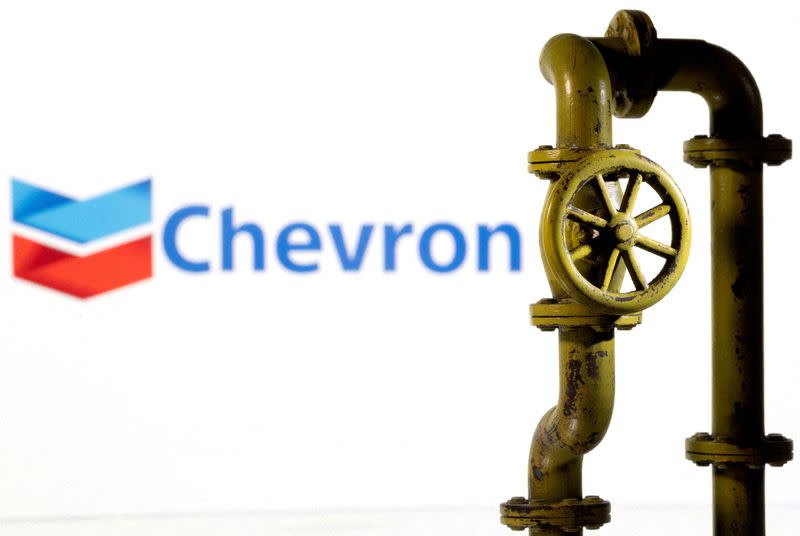Chevron to buy Hess Corp for $53 billion in all-stock deal

LONDON (Reuters) -Chevron Corp said on Monday it would buy smaller rival Hess Corp in a $53 billion all-stock deal, taking its rivalry with Exxon Mobil to the next level by boosting its presence in U.S. shale and oil-rich Guyana.
Following are reactions from analysts and investors:
ROYAL BANK OF CANADA
Given that Exxon Mobil had effectively taken itself out of the running for large-scale M&A following the recent Pioneer deal, we would have thought Chevron could bide its time, and hence we are a little surprised at the timing of this deal.
It does address the concerns with Chevron's portfolio - namely over concentration in the Permian and lack of depth in growth elsewhere, however it comes at a price given the relative multiples between the two companies.
In the end, Chevron walks away with a stronger, more diversified portfolio, which should bode well for shareholders over the long term, but in the near term, the news could weigh on the shares.
MKP ADVISORS
Hess has been touted as a potential target for the super-majors for some time; it had been mainly the stance of John Hess as a non-seller that was perceived as the reason why this has not happened before. Entering his 70th year, it seems he has got to the point where he sees a transition of Hess to a new ownership structure is appropriate.
Perhaps, we once again get some pushback about the concept of large scale U.S. super-majors pivoting back to fossil fuel exposure rather than building out renewables etc, but this is more a topic for Chevron’s shareholders and management rather than a threat to this deal.
PETER MCNALLY, THIRD BRIDGE
The recent flurry of acquisition activity from Chevron and Exxon Mobil reminds Third Bridge experts of the building of the "super majors" that began 25 years ago, an era that transformed the oil industry into the massive companies that we see today.
Back then, the super majors were consolidating to drive costs lower. Today, the companies being acquired today like Hess and Pioneer Natural Resources have more concentrated asset bases and expertise built in developing specific resources.
VIKTOR KATONA, KPLER
Hess has minimal presence in the Permian basin yet is one of the leading producers in the Bakken basin in North Dakota, so Chevron is expanding its outreach rather than zooming in on one specific play.
The transaction might also create a peculiar coexistence of the United States' two leading oil majors in Guyana... Suddenly Chevron becomes a big player in Guyana just as the country is ramping up production towards the 1 million bpd (barrels per day) threshold.
But it is also coexisting with one of its biggest competitors in the game, within the same project. Hess is geared towards crude production, with oil accounting for 60% of its current output which fits in very nicely with Chevron's similarly oil-focused portfolio.
ROBIN HELANDER, RYSTAD ENERGY
North America-based M&A has surpassed $130 billion prior to the Chevron-Hess merger, setting a record high over the previous seven years. The stage is certainly set for increased M&A and industry consolidation, given the record profits generated last year, where public E&Ps (exploration and production companies) increased their collective cash reserves on balance sheets by 50% to nearly $300 billion.
On the deal itself, the Chevron-Hess merger is expected to have a significant impact on the shale oil industry with Chevron becoming the second-largest shale producer in the United States. The merger is also likely to lead to increased M&A and industry consolidation in the North America shale sector.
TD COWEN ANALYSTS
While the value appears fair, Hess had a highly visible growth profile that did not signal the need for an imminent sale.
Ironically, many investors were looking to substitute funds allocated from the recently sold Pioneer Natural Resources (to Exxon) into Hess as a large cap, growth alternative.
There is minimal operational overlap outside of the Gulf Of Mexico and should attract little FTC pushback.
UBS ANALYSTS
Sector consolidation is happening at full speed and remains a positive driver of performance. We see more transactions occurring as potential sellers are getting 5-15% premiums vs. no premiums in 2020-21.
Additionally, all-stock transactions maintain balance sheet strength while strengthening shareholder returns.
MARK VAN BAAL, FOLLOW THIS
With this deal, Chevron is betting on the failure of the Paris Climate Agreement to limit climate warming. Big oil needs to change or Paris will fail. That's a decision for shareholders.
TRUIST SECURITIES ANALYSTS
We were surprised by the deal given Exxon operates Hess' largest asset (Guyana ~75% of total company value), which will continue to be one of Chevron's largest assets going forward.
Further, we believed Chevron would buy another company with more contiguous assets to their existing positions.
We believe the $10 billion and more sales, and potential lower combined activity could impact various smaller E&Ps along with midstream/OFS (oilfield service) providers.
(Reporting by Seher Dareen, Ron Bousso and Dmitry ZhdannikovEditing by Mark Potter and Barbara Lewis)

 Yahoo Finance
Yahoo Finance 